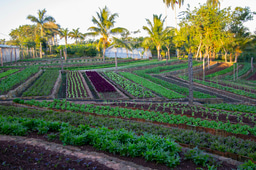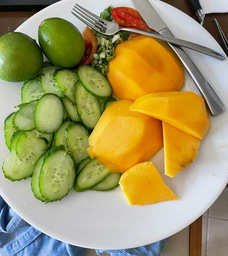Blog Post 3 - Each Green Corner

Hunger in the U.S. is mostly a racial equity issue. This is much different than in Cuba, as the food issues in Cuba do not typically link to race and more so to the relationships other countries have with Cuba. Historically, in the United States, marginalized communities in the United States have dealt with poverty and food insecurity at a much higher rate than white people. Each Green Corner works to supply accessible foods with their food gardens to combat these issues.
Before Each Green Corner, I did not know much about how food gardens operate in the United States. Each Green Corner works to start gardens wherever they can grow, including private residences, schools, parks, government buildings, open spaces, and commercial properties. As mentioned in my introduction post, Each Green Corner works to promote sustainable, permaculture-based urban agriculture and to educate the community around them and give them the tools to make an impact on public and environmental health and food security.
One of the main goals of Each Green Corner is to produce more culturally diverse foods. Most food gardens in America produce food that's cheap, and those foods are typically not diverse. Since Each Green Corner is 100% powered by volunteers, they take the extra step to ensure that the food they grow is culturally diverse, such as tomatillo, persimmon, and apricots. Each Green Corner has over 15 food-producing gardens and has donated and harvested over 10,000 pounds of fresh locally-grown food.
A lot of the work I did for Each Green Corner was cleaning up their data and observing how successful they have been in terms of returning volunteers and number of events they have been hosting. For example, I spent this past week going through responses to a survey they handed out to their volunteers. After tallying up the responses, I also took the time to understand the areas they could improve in. For instance, as of now, it's difficult to track who is repeatedly coming to help out in the gardens and a lot of the time it's one timers or the same two people that keep coming. There are also isn't a pattern when it comes to which months have the biggest number of volunteers. You would think it'd be the summer, but it's truly all over the place, which tells me that the potential is there but the advertising is not.
Overall, Each Green Corner does a fantastic job when it comes to aligning goals and visions for food security in the United States. However, it is very difficult to run something that is a non-profit and completely volunteer based. I definitely see growth in Each Green Corner's future and urge all of you to check it out; if you live in the San Carlos/Redwood City area of California, see if you can spend some time in their gardens! Stay tuned for my final post next week where I will bring Cuba's and Each Green Corner's stories together and share my final thoughts and findings.




Please sign in
If you are a registered user on Laidlaw Scholars Network, please sign in